Conclusion
In Somerset, Normandy, and the Basque region hundreds of years ago, cidermakers learned from one another. They traded information about which apples and fermentation processes made for the best cider. They experimented with new varieties and methods that are now considered classic and authentic. It was these collaborations that led to the geographic styles often called traditional.
Today’s cidermaking community is more geographically diverse, connected by airplanes and the internet, not country back roads, but the same kind of information exchange is improving modern cidermaking. Cider drinkers, for their part, faced with an increasing number of cider options, are discovering that there are many different approaches to cider for many different tastes, much as mass-market beer drinkers discovered during the craft beer boom.
At Poverty Lane Orchards, a knock at the loading dock door of the cider room is as likely to be a neighbor clutching a growler to be filled with one of Farnum Hill Ciders Dooryard batches as it is to be an apple grower or young cidermaker seeking grafting wood or fermentation advice. For the crew behind Farnum Hill Ciders, fostering a community of like-minded cidermakers is nearly as important as making cider itself.
Home cidermakers are a growing community within this cider world and can similarly influence it, asking their local farmers for cider apples, supporting other cidermakers and, simply, sharing a great cider with a friend at the bar.
Already, an increased interest in cidermaking has led to an increase in the cultivation of cider apples. This era of cider is too young to lay claim to a style, but the philosophy shared by the cidermakers in this book—the idea the cider should be an expression of the apples—is taking hold, both among cidermakers and cider drinkers.
There’s one piece of advice every would-be cidermaker needs: It’s all about the apple. For home cidermakers who have practiced the techniques in this book and want to continue to improve their cidermaking skills, that means seeking out ever-better cider apples and continuing the tradition of cidermaking.


